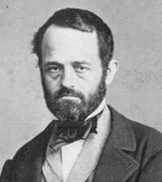
Annibale de Gasparis
Encyclopedia

Italy
Italy , officially the Italian Republic languages]] under the European Charter for Regional or Minority Languages. In each of these, Italy's official name is as follows:;;;;;;;;), is a unitary parliamentary republic in South-Central Europe. To the north it borders France, Switzerland, Austria and...
astronomer
Astronomer
An astronomer is a scientist who studies celestial bodies such as planets, stars and galaxies.Historically, astronomy was more concerned with the classification and description of phenomena in the sky, while astrophysics attempted to explain these phenomena and the differences between them using...
. From 1864 to 1889 he was the director of the Astronomical Observatory of Capodimonte
Astronomical Observatory of Capodimonte
The Osservatorio Astronomico di Capodimonte The Osservatorio Astronomico di Capodimonte The Osservatorio Astronomico di Capodimonte (Astronomical Observatory of Capodimonte is an astronomical observatory owned and operated by Italy's Istituto Nazionale di Astrofisica (National Institute for...
in Naples
Naples
Naples is a city in Southern Italy, situated on the country's west coast by the Gulf of Naples. Lying between two notable volcanic regions, Mount Vesuvius and the Phlegraean Fields, it is the capital of the region of Campania and of the province of Naples...
.
He won the Gold Medal of the Royal Astronomical Society
Gold Medal of the Royal Astronomical Society
-History:In the early years, more than one medal was often awarded in a year, but by 1833 only one medal was being awarded per year. This caused a problem when Neptune was discovered in 1846, because many felt an award should jointly be made to John Couch Adams and Urbain Le Verrier...
in 1851.
The asteroid 4279 De Gasparis
4279 De Gasparis
4279 De Gasparis is a main-belt asteroid discovered on November 19, 1982 by Osservatorio San Vittore at Bologna.- External links :*...
as well as the lunar
Moon
The Moon is Earth's only known natural satellite,There are a number of near-Earth asteroids including 3753 Cruithne that are co-orbital with Earth: their orbits bring them close to Earth for periods of time but then alter in the long term . These are quasi-satellites and not true moons. For more...
crater
Impact crater
In the broadest sense, the term impact crater can be applied to any depression, natural or manmade, resulting from the high velocity impact of a projectile with a larger body...
de Gasparis
De Gasparis (crater)
de Gasparis is a lunar crater that is located in the southwest part of the Moon. It lies to the southwest of the crater Cavendish and south of Mersenius.The rim of de Gasparis is worn and eroded, and the interior has been flooded by basaltic lava...
(30 km in diameter) and the Rimae de Gasparis (a 93 km long fracture near the crater) are named in his honour.
| 10 Hygiea 10 Hygiea 10 Hygiea is an asteroid located in the asteroid belt. With somewhat oblong diameters of 350–500 km, and a mass estimated to be 2.9% of the total mass of the belt, it is the fourth largest asteroid by volume and mass... |
April 12, 1849 |
| 11 Parthenope 11 Parthenope 11 Parthenope is a large, bright main-belt asteroid.Parthenope was discovered by Annibale de Gasparis on May 11, 1850, the second of his nine asteroid discoveries. It was named after one of the Sirens in Greek mythology, said to have founded the city of Naples... |
May 11, 1850 |
| 13 Egeria 13 Egeria 13 Egeria is a large main-belt G-type asteroid.It was discovered by A. de Gasparis on November 2, 1850, and was named by Urbain J. J. Le Verrier, whose computations led to the discovery of Neptune. Egeria was a goddess of Aricia, in Italy, and the wife of Numa Pompilius, second king of... |
November 2, 1850 |
| 15 Eunomia 15 Eunomia 15 Eunomia is a very large asteroid in the inner asteroid belt. It is the largest of the stony asteroids, and somewhere between the 8th-to-12th-largest main-belt asteroid overall... |
July 29, 1851 |
| 16 Psyche 16 Psyche 16 Psyche )is one of the ten most massive main-belt asteroids. It is over 200 kilometers in diameter and contains a little less than 1% of the mass of the entire asteroid belt. It is the most massive of the metallic M-type asteroids.... |
March 17, 1852 |
| 20 Massalia 20 Massalia 20 Massalia is a large and fairly bright main-belt asteroid. It is also the largest member of the Massalia family of asteroids. Its name is the Greek name for Marseille, the city from which one of the two independent co-discovers, Jean Chacornac, first sighted it.- Characteristics :Massalia is an... |
September 19, 1852 |
| 24 Themis 24 Themis 24 Themis is one of the largest main-belt asteroids. It is also the largest member of the Themistian asteroid family. It was discovered by Annibale de Gasparis on April 5, 1853... |
April 5, 1853 |
| 63 Ausonia 63 Ausonia 63 Ausonia is a large main belt asteroid. It was discovered by Annibale de Gasparis on February 10, 1861 from the Astronomical Observatory of Capodimonte, Naples. The initial choice of name for the asteroid was "Italia", after Italy, but this was modified to Ausonia, an ancient classical name for... |
February 10, 1861 |
| 83 Beatrix 83 Beatrix 83 Beatrix is a quite large asteroid orbiting in the inner part of the main asteroid belt. It was discovered by Annibale de Gasparis on April 26, 1865. It was his last asteroid discovery. A diameter of at least 68 km was determined from the Beatrician stellar occultation observed on June 15,... |
April 26, 1865 |

